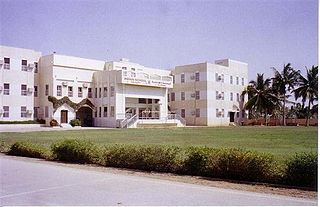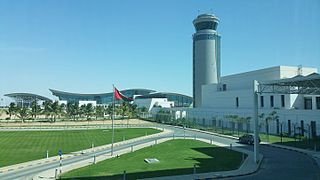
Oman, officially the Sultanate of Oman, is a country on the southeastern coast of the Arabian Peninsula in Western Asia. Formerly a maritime empire, Oman is the oldest continuously independent state in the Arab world. Located in an area bordering the mouth of the Persian Gulf, the country shares land borders with Saudi Arabia, United Arab Emirates, and Yemen, and shares maritime borders with Iran, and Pakistan. The coast is formed by the Arabian Sea on the southeast, and the Gulf of Oman on the northeast. The Madha and Musandam exclaves are surrounded by UAE on their land borders, with the Strait of Hormuz and the Gulf of Oman forming Musandam's coastal boundaries. Muscat is its capital and largest city.

Oman is a country on the southeast coast of the Arabian Peninsula, situated in Southwest Asia, bordering the Arabian Sea, Gulf of Oman, and Persian Gulf, between Yemen and the United Arab Emirates (UAE). The coast of Oman was an important part in the Omani empire and sultanate.

Muscat is the capital city and is the most populated city in Oman. It is the seat of the Governorate of Muscat. According to the National Centre for Statistics and Information (NCSI), the total population of Muscat Governorate was 1.4 million as of September 2018. The metropolitan area spans approximately 3,500 km2 (1,400 sq mi) and includes six provinces called wilayats. Known since the early 1st century AD as an important trading port between the west and the east, Muscat was ruled by various indigenous tribes as well as foreign powers such as the Persians, the Portuguese Empire, the Iberian Union and the Ottoman Empire at various points in its history. A regional military power in the 18th century, Muscat's influence extended as far as East Africa and Zanzibar. As an important port-town in the Gulf of Oman, Muscat attracted foreign tradesmen and settlers such as the Persians and the Balochis. Since the ascension of Qaboos bin Said as Sultan of Oman in 1970, Muscat has experienced rapid infrastructural development that has led to the growth of a vibrant economy and a multi-ethnic society. Muscat is termed as a Beta - Global City by the Globalization and World Cities Research Network.

Said bin Taimur was the 13th Sultan of Muscat and Oman from 10 February 1932 until he was deposed on 23 July 1970 by his son Qaboos bin Said.

The Dhofar Governorate is the largest of the 11 Governorates in the Sultanate of Oman in terms of area. It lies in Southern Oman, on the eastern border with Yemen's Al Mahrah Governorate. It is a rather mountainous area that covers 99,300 km2 (38,300 sq mi) and has a population of 416,458 as of the 2020 census. The largest city, as well as capital of the Governorate, is Salalah. Historically, the region was a source of frankincense. The local variety of Arabic is Dhofari Arabic, which is quite distinct from that of the rest of Oman and from Yemen.

Salalah is the capital and largest city of the southern Omani governorate of Dhofar. Its population in 2009 was about 197,169.

The Dhofar Rebellion, also known as the Dhofar War or the Omani Civil War, was waged from 1963 to 1976 in the province of Dhofar against the Sultanate of Muscat and Oman. The war began with the formation of the Dhofar Liberation Front, a group which aimed to create an independent state in Dhofar, free from the rule of the Omani Sultan Said bin Taimur. The rebels also held the broader goals of Arab nationalism which included ending British influence in the Persian Gulf region.
The Education in Oman is provided free of charge up to the end of secondary education, though attendance is not mandatory at any level. In 1970 there were only three formal schools with 900 students in the whole country. Oman's national educational program expanded rapidly during the 1970s and the 1980s. In 2006–2007 about 560,000 students attended 1053 public schools. The number of students in private schools is about 65,000. There are also extensive programmes to combat adult illiteracy. Sultan Qaboos University, the only national university near Muscat, was founded in 1986, and in 2006 it had 13,500 students. The Human Development Report found the literacy rate to be 93.0% in adults, up from 54.7% in 1990. For the same period, the youth literacy rate increased from 85.6 to 97.3%. Public expenditure on education was reported to be 4.6% of GDP and 26.1% of total government spending.
The Indian School Al-Ghubra (ISG) is an independent, co-educational private day school located in the city of Muscat in the Sultanate of Oman. The school was founded in July 1990 by Indian born Omani businessman P Mohamed Ali, the managing director of Galfar Engineering and Contracting.

Dhofar Sports, Cultural and Social Club is an Omani sports club based in Salalah, Oman. The club is currently playing in the Oman Professional League, top division of Omani football. Their home ground is Al-Saada Stadium, but they also recognize the older Salalah Sports Complex as their home ground. Both stadiums are government owned, but they also own their own personal stadium and sports equipment, as well as their own training facilities.

Al-Nasr Sports, Cultural and Social Club is an Omani sports club based in Salalah, Oman. The club is currently playing in the Oman Professional League, top division of Oman Football Association. Their home ground is Al-Saada Stadium, but they also recognize the older Salalah Sports Complex as their home ground. Both stadiums are government owned, but Al-Nasr S.C.S.C. also own their own personal stadium and sports equipment, as well as their own training facilities. Also Al-Nasr is famous for producing some of the greatest and most successful Omani footballers, such as Ali Al-Habsi, Hashim Saleh and Fawzi Bashir.
Indian School Al Wadi Al Kabir (ISWK), established in 1978, is located in the city of Muscat, Oman. The school was founded by Founded in 1941 as a Gujarati Medium School for the children of the members of the business community. Mr. Lobo was principal of the school since 1990 to spring 2008. Later there was another principal Mr.P.N.Ashok who resigned in 2012. The present principal is Mr. D. Nageswar Rao.
The IISR, formerly known as Embassy of India School, Riyadh is an English-medium Indian school located in Riyadh, Saudi Arabia. It is one of the largest Indian schools with close to 9500 students. The students are locally known as "iisrians". The School is part of global International Indian Schools including International Indian School, Dammam, International Indian School Jeddah, International Indian School, Al-Jubail and is affiliated to the Central Board of Secondary Education (C.B.S.E), New Delhi, India and is licensed under the Ministry of Education, Kingdom of Saudi Arabia. The School endeavors to move towards fulfillment of above goals under the patronage and guidance of His Excellency Ahmed Javed, Ambassador of India to the Kingdom, and the Patron of the school.

The Indian School Salalah is an Indian-run, self-financing, co-educational institution, primarily established to meet the academic needs of children of Indian expatriates working in the Sultanate of Oman in the Persian Gulf. The school also admits children of other nationalities. The school is located in the Dahariz area, of Salalah town, in the southern governorate of Dhofar.
The Khawrs of the Salalah Coast Reserve are a group of eight natural reserves in the Dhofar Governorate of Oman. They consist of lagoons and vary in size from a few hectares to more than one hundred hectares.

Pakistan School Muscat (PSM) is a state of Art school in the Sultanate of Oman. It was founded in a rented flat in Muscat, as a result of a decision made in the first meeting of Pakistani Culture Centre. Efforts, spearheaded by Mr. and Mrs. S. M. Shafi, were made to collect funds and as a result the school was shifted to its spacious campus in January 1981. His Majesty Sultan Qaboos granted land in Darsait that enabled the school to be established. Since then, the school has seen exceptional growth, both in terms of enrolment and size.
Pakistan School Salalah is a community school in Oman, and it was established in 1982. The school is situated in Salalah, Dhareez north with an area of 15,000 square metres (160,000 sq ft). The school is running classes from the nursery level to grade 12. The school covers the area of 15,000 sq.m. The school building is elegant and geared with all necessary facitlites.
British School Salalah (BSS) is a non-private English language international school in the Dhofar region of Oman.

Salalah International Airport is the Sultanate of Oman's secondary international airport after Muscat International Airport. It is located on the Salalah coastal plain in the Dhofar Governorate, 5.5 kilometres (3.4 mi) northeast of Salalah's city centre. The airport features flights to regional destinations as well as a few intercontinental charter services from Europe. The airport recently won the Skytrax 5-Star Regional Airport Rating for its excellence in management and service.

The Dhofar Mountains are a mountain range in the southeastern part of the Arabian Peninsula. In a broad sense, they extend from Dhofar Governorate in Oman to Hadhramaut Governorate in Yemen, and are located between the Hajar in the northern part of Oman, and the Sarawat in the western part of Yemen. Otherwise, the range in the eastern part of Yemen, particularly near Mukalla, is referred to as the "Hadhramaut" or "Mahrat".













